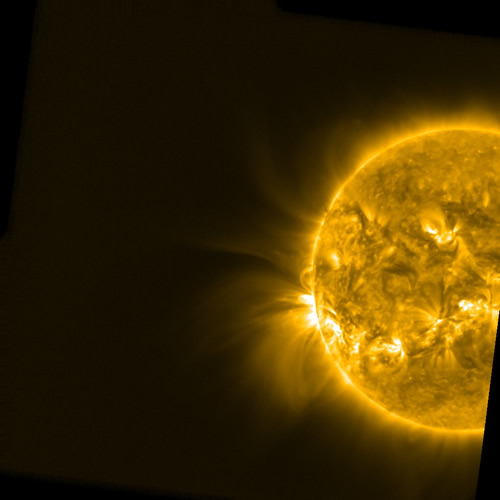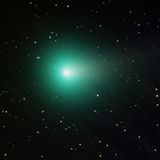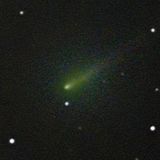
Comet ISON gave everyone a thrill ride on Thursday, November 28, when it reached perihelion. While there are clear images from the Solar and Heliospheric Observatory that show the comet swinging around the Sun, there was one activity at the star party the enigmatic comet seems to have skipped over - the SWAP meet. The Sun Watcher using Active pixel system detector and image Processing solar telescope, on board the Belgium-based ESA mission PROBA2 was watching the encounter. Even though at least a part of the icy traveler may have survived its barbeque brush with the Sun, it failed to appear in images from extreme-ultraviolet (EUV) solar telescopes on Thursday, to the disappointment of many.

Image: A processed SWAP EUV image from the Comet ISON campaign shows no hit of the comet's passage. Credit: Royal Observatory of Belgium
Thanks to several space-based ultra-violet solar telescopes, solar physicists have had the opportunity to study a few sungrazing comets over the last two decades. Usually they appear very bright in the EUV images, showing themselves highlighted in the Sun's atmosphere as they skim past the surface. In 2011, Comet Lovejoy gave a fine performance, adding its signature data to not only comet studies, but the Sun's magnetic properties as well. It gave a glowing report that left a trail which could be followed along the flows of the magnetic field of the solar corona. Since there are very few comets which travel close enough to the Sun to be visible to these specialized instruments, scientists at the Royal Observatory of Belgium, which operates PROBA2 (Project for Onboard Autonomy), had high hopes that ISON would be among them, giving answers to questions about not only comets and the Sun, but the solar system itself.
"We made every effort to observe Comet ISON," said Dr. Daniel Seaton, lead scientist for SWAP at the Royal Observatory of Belgium. "Unfortunately, the comet simply didn't appear in our images. In principle, we had every reason to think our telescope would see it, so why we did not only deepens the mystery of a perplexing comet. "
Comet ISON has been something of a mystery since it was first sighted. This rocky collection encased in frozen gases has been orbiting in the Oort Cloud for some 4.5 billion years and may have originated as much as a light year away from the inner solar system. This means it was in a pristine state - nearly untouched since the time the solar nebula congealed into a full blown planetary system. Scientists were anxious to take a look at anything it had to offer, offerings which came from our solar system's first moments. Of course, they would be something akin to burnt offerings since ISON would pass the Sun's surface just a scant 1.2 million kilometers away!
"The last comet we saw with SWAP, Comet Lovejoy, passed barely 100,000 km from the Sun's surface," said Dr. Seaton. "That's closer than the Earth is to the Moon. So one possibility is that Comet ISON was simply too far away from the Sun to be visible. There are quite a few factors that determine whether or not SWAP can see something."
The UV telescopes which study the Sun each have their own personalities and capabilities. SWAP's specialty is its ability to make observations of iron and oxygen atoms in the solar corona as far distant from the Sun as 2 million kilometers, much farther than most other active solar observatories.
"One possibility is that the comet, despite its close approach to the Sun, simply wasn't composed of material our imager can actually see. Another is that the material evaporated from the comet didn't reach the million degree temperatures which would allow it to be seen with SWAP," said Dr. Seaton.
At first the baffling comet was reported to have been doomed. It appeared that ISON had simply disintegrated as it reached its solar encounter. However, the comet continued to amaze researchers by apparently surviving at least partially, its remains destined to be consigned to deep space once again. Dr. Laurel Rachmeler, also of the Royal Observatory of Belgium said that the comet would remain a mystery for solar physicists and other astronomers to puzzle over in the months to come. "Of course we were hoping to see something a little more spectacular in our telescope," she said, "but there is still plenty to do before we can solve this little riddle. The suspense for us has passed, but now the fun part starts as we begin to fit all of our information together."
Are we through with Comet ISON? Not hardly. Astronomers around the world will continue to observe the remains of the comet as it leaves our solar system. SWAP scientists will also be busy trying to solve the riddle of why they weren't able to image the comet.
"It's a mystery for sure," said Dr. Seaton, "but a non-detection is still important information. Our hope is that our data - or rather, our lack of data - will be combined with images and observations from the global effort to understand this comet and will help give us new insight into some of the most distant bodies in our solar system."
Original Story Source: PROBA2 Science Center News Release
About Tammy Plotner - Tammy is a professional astronomy author, President Emeritus of Warren Rupp Observatory and retired Astronomical League Executive Secretary. She's received a vast number of astronomy achievement and observing awards, including the Great Lakes Astronomy Achievement Award, RG Wright Service Award and the first woman astronomer to achieve Comet Hunter's Gold Status.


















